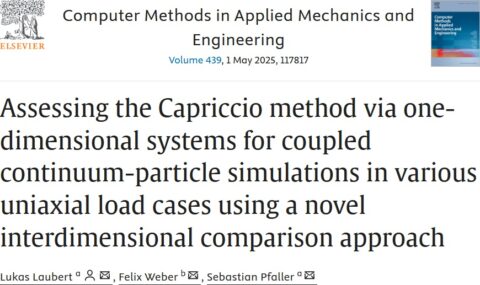New Paper in Computer Methods in Applied Mechanics and Engineering
We are pleased to announce the publication of “Assessing the Capriccio method via one-dimensional systems for coupled continuum-particle simulations in various uniaxial load cases using a novel interdimensional comparison approach” in Computational Methods in Applied Mechanics and Engineering.
https://doi.org/10.1016/j.cma.2025.117817
This paper investigates the sources of insufficiencies observed with the Capriccio method for concurrent continuum-particle coupling using a novel comparison technique. The approach maps deformation states of 3D coupled domains into a concise 1D representation, allowing for separate evaluation of domain strains in a unified format. For the investigation, both a 1D coupled system resembling essential features of the full 3D Capriccio method and a corresponding 3D setup are employed. Our analysis explores interactions between different material models in finite element (FE) and molecular dynamics (MD) domains. We identify resistance of the coupling region to spatial movement as a fundamental cause of strain convergence problems when applying the staggered solution scheme. Examination of the 3D setup reveals exacerbated strain inconsistencies due to adverse relaxation effects in viscous MD models, especially when coupled with a viscoelastic–viscoplastic FE model. Our findings confirm that smaller strain increments with larger load step numbers significantly improve strain convergence. The study suggests the need for sensitivity analysis of coupling parameters to reduce motion resistance and recommends exploring monolithic solving schemes for 3D systems to achieve optimal strain convergence in Capriccio-based models. Finally, this approach may serve as a model to assess other domain-decomposition coupling techniques.

